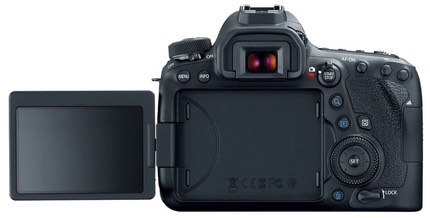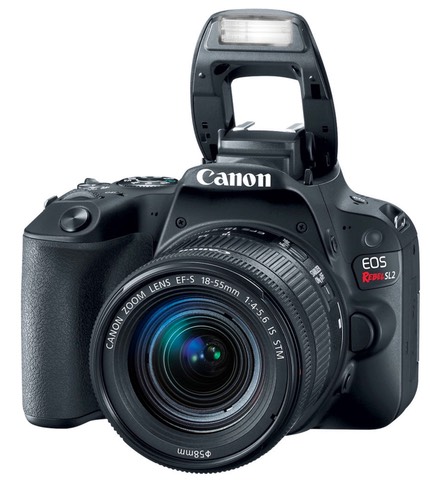
Canon today announced the second version of their "budget" full frame DSLR, the US$1999 6D Mark II, and on National Camera Day, which at least shows some attention to marketing detail ;~). There are some interesting contrasts in this iteration that are going to generate some controversy, I think.
The thing I noticed immediately is that the Mark II model has shed a significant 5 ounces in weight, and is trimmer in every dimension than its predecessor. Curiously, Canon didn't mention that in their press release. Bu that change is definitely on trend: to compete with the mirrorless models and to continue to cater to the aging DSLR owners, pulling out size and weight without sacrificing anything else is imperative. The 6D Mark II is on target with that.
The thing that will probably get talked about the most, though, is the lack of 4K video. The time lapse mode of the camera will create 4K video if you want, but the primary video capabilities top out at 1080P/60. And that's a cropped 1080P from the full frame, as we have electronic five-axis video stabilization for the video.
There's a real question as to whether 1080P/60 is behind trend now or not. For casual video use, 1080P is probably still appropriate, as 4K can run up enormous storage requirements very quickly, is still a pain to edit except on state-of-the-art computers, and generally requires time-consuming and additional storage hogging transcoding, as the still camera world simply hasn't discovered that we serious video folk really want directly editable ProRes and/or raw video capabilities.
Meanwhile, most of the rest of the 6D Mark II is pretty much the same as the original, within a design wiggle or waggle and a technology update or two. You get WiFi with Bluetooth and NFC, plus built-in GPS, something that Nikon is starting to get all miserly on these days. Some Nikon DSLRs are Bluetooth only, and built-in GPS apparently costs too much money for the Nikon accounting department; I'm tempted to say Nikon is "lost," but that would be a pun-ishment to readers ;~).
Overall, the 6D Mark II is mostly a "business as usual" update from Canon. Much like Nikon has been "business as usual" in their DSLR updates recently. This is a tricky thing the Canikon duopoly is attempting. Mirrorless cameras are the only growth prospect left in dedicated cameras now. DSLR volume is coming down by 10% a year. Whether the collision course in ILC produces deep impact in 2018, 2019, 2020, or later is debatable, but we're nearing the end of the DSLR reign in terms of sheer dominance in high-end cameras.
The natural transition point is with the low-end cameras, much as Canon has done with EOS M lately versus their EF-S DSLRs. You update the DSLRs as usual and then undercut them a bit with a wisely designed mirrorless model. Eventually the mirrorless models start to predominate over the low-end DSLR and you begin migrating mirrorless upwards. But you keep iterating your DSLR for the remaining dedicated. That's the simplest and most natural progression, I believe.
The problem, of course, is that Fujifilm is all-in with mirrorless and highly competitive with low and mid-range DSLRs at the moment. Meanwhile, Sony is throwing the electronic kitchen sink into everything they produce, also putting them squarely in the competitive-with-DSLRs market. Even Olympus and Panasonic—with the E-M1 Mark II and GH5 respectively—are pointed right at the heart of the Canikon DSLR dominance.
If I'm right about the natural transition, there will be a Canon EOS FM before a 6D Mark III appears. First, try to max out the full frame DSLR sales, next get into the full frame mirrorless line at the most affordable point, then eek out a few remaining full frame DSLR upgraders with a bigger Mark III update, then move the full frame mirrorless camera up into that position or higher.
The interesting problem for Canon that Nikon doesn't yet have is that the mirrorless world has reverse engineered the Canon EF mount well enough that Sony FE adapters provide pretty decent EF lens compatibility already. Canon doesn't have a lot of time to leverage their lens legacy, as right now that is producing leaks to a competitor.
I have to believe a Canon EOS FM (full frame mirrorless) will appear in 2018.

Meanwhile, the EOS SL2 (200D in some markets) was also introduced by Canon, and illustrates the point I made above: undercut the DSLR (with EOS M) but keep iterating DSLRs to pick up the committed customers (with SL2). At 453g, the SL2 isn't much heavier than a mirrorless EOS M5 (427g), though it is bigger in every dimension. While the Nikon D3400 is slightly lighter than the SL2, it is bigger and bulkier, and omits things like the swivel LCD the SL2 has. Meanwhile, the SL2 doesn't really have any clear features or performance that put it clearly above the M5, but it also doesn't require an adapter to use EF/EF-S mount lenses and manages more shots per charge on the same battery. All at a lower price than the M5 (US$549 body only).
Canon, in essence, is telling the crop sensor DSLR users that they can go either way, mirrorless or DSLR, and by keeping the cameras close enough the advantages of each approach are the primary differential. Emptor velit. No other camera maker has really attempted this approach, and I'll bet it's giving Canon plenty of interesting data from which to make future decisions.
Meanwhile, Nikon's D3400 is an impressive bargain, but it's floundering in sales because it's in no-man's land. It's a bit big like a DSLR, a bit light like a mirrorless. It's defeatured unfortunately, and Nikon has no clear path or choice for someone wanting to get to mirrorless.
Canon's making the right decisions. Nikon is not.
And now the ball is in Nikon's court. The D610 is Nikon's 6D equivalent and well overdue for replacement. Nikon has no real EOS SL equivalent and absolutely no EOS M equivalent. These are critical cameras, because they define the bottom end of several lines of ILC cameras. Canon has rationalized that and is moving forward, while Nikon is still struggling to figure out how everything fits together.
Is it no wonder that Canon took market share away from Nikon last year and probably continues to do so this year?
Support this site by purchasing from the following advertiser:





